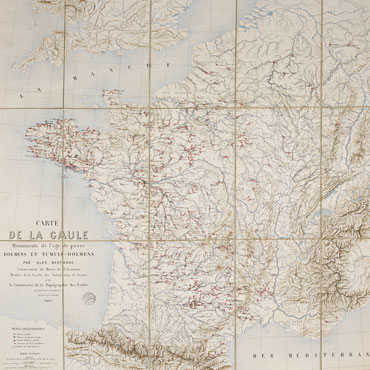
- Home
- The Commission de Topographie des Gaules
- Scientific archaeology
- The first archaeological map of France
The carte archéologique nationale unites and organises the archaeological data known to date for the whole of France. Its production is now the responsibility of the state. The work of the Commission de Topographie des Gaules (CTG) between 1858 and 1879 was the first attempt at archaeological cartography on this scale.
Three maps, three dictionaries
In the summer of 1858, the CTG’s objective was to produce three maps of Gaul. The first was to represent the Celtic period, understood to be Gaul before the Roman conquest; the second, the Gallo-Roman period; and the third, Gaul during the Merovingian period. Each of these maps required an accompanying dictionary to facilitate its reading, with each site referenced on a map also recorded in the corresponding dictionary.
To help it with this cartographical work, the CTG sent forms from its central office to all its correspondents around the country. These official forms were divided into two columns, one for the Celtic period and one for the Gallo-Roman period (the Merovingian period was quickly laid aside). These columns contained several headings, each with a specific symbol which would appear on the maps representing, for example, dolmens, metal artefacts, coins, roads and milestones, camps and surrounding walls, burial mounds, cemeteries and tombs, aqueducts, arenas, amphitheatres and theatres, and underground spaces and caves.
The Dictionnaire archéologique de la Gaule
The project as it was initially conceived did not come to fruition. While all the maps were completed, only one part of the Dictionnaire archéologique de la Gaule – Époque celtique was published between 1875 and 1878. However, this was a significant work in itself. It was organised as a directory of sites, with each record referencing written sources, quoted and commented upon, archaeological remains either excavated or seen, and bibliographical references. This first archaeological map contained no less than 3,005 entries.





